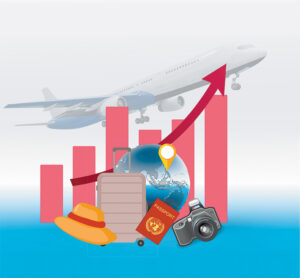




Philippines Trade Update: Trade trajectories trend along
 DOWNLOAD
DOWNLOAD

Policy Rate Updates: Double cut finale
 DOWNLOAD
DOWNLOAD

Monthly Economic Update: One for the road
 DOWNLOAD
DOWNLOAD


Tracking the comeback of Philippine tourism

Tourism is getting back on foot after its expansion got blown by the coronavirus disease 2019 (COVID-19) lockdowns and travel restrictions. Although the number of visitor arrivals and domestic trips in the country has yet to reach their pre-pandemic levels so far, the relaxation of restrictions has somehow driven the industry to move forward.
Since the easing of the country’s border restrictions in February, the Philippines has welcomed two million visitors, according to the Department of Tourism (DoT).
As of Nov. 14, the department reported a total of 2,025,421 visitor arrivals to the country, 73.43% or more than 1.48 million of which are foreign tourists, while over 538,000 (26.57%) are overseas Filipinos.
Among these foreign tourist arrivals, 19.01% came from the United States of America, the highest number of foreign tourist arrivals count by country. South Korea followed with 14.10%, then Australia with 4.75%.
Canada, the United Kingdom, Japan, India, Singapore, Malaysia, and Vietnam completed the top 10 list of countries with the most tourist arrivals to the Philippines.
Visitor arrivals from February to September brought over P100.7 billion in revenues to the tourism sector, soaring 1,938.14% from the P4.94 billion recorded in the same period in 2021.
The two million visitor arrivals surpassed the DoT’s 1.7 million tourist projections, said Tourism Secretary Christina Garcia-Frasco.
“We therefore must meet this with the continued implementation of enabling mechanisms that will convey not only the country’s openness to welcome more tourists but also conduciveness to tourism business and livelihood opportunities for our fellow Filipinos,” she said in a statement.
In 2021, the Philippines recorded only 163,879 visitor arrivals, an 88.95% slump from the 1.48 million seen in the year prior, according to data from the DoT.
Meanwhile, the 2021 Philippine Tourism Satellite Accounts (PTSA) reported that demand for domestic tourism increased by 38.16% to more than 37 million trips last year. The top overnight destinations for local tourists were the National Capital Region, Calabarzon (Cavite, Laguna, Batangas, Rizal, and Quezon), and Central Luzon.
Employment in tourism industries also increased by 4.6% in 2021, with 4.9 million employed individuals. Overall, tourism generated 11.1% of the country’s total employment in the previous year.
In addition, passenger transport has the highest share of employment among the tourism industries, accounting for 38.3%.
In 2021, the tourism sector’s contribution to the country’s gross domestic product (GDP) inched up to 5.2%, amounting to P1 trillion.
Philippine tourism is expected to reach pre-pandemic levels by 2024, as industry stakeholders told BusinessWorld in a report last June, though the demand could be challenged by certain factors such as high inflation.
The country welcomed over 8.26 million visitor arrivals back in 2019, while about 122 million domestic trips were tallied. The tourism sector’s share in the country’s GDP then was at 12.7% or P2.48 trillion.
Plans for tourism recovery
The DoT, last August, laid out its plans and programs for the recovery of the tourism industry. Among these were the establishment of tourist service rest areas, a Tourist Assistance Call Center, improvements in land and sea tourist facilities, the launch of a guest incentive system, ensuring visitors’ health and security, and the development of the Tourist Lifecycle App, among others.
Ms. Frasco shared that at least 10 tourist service rest areas would be set out in strategic locations in Luzon, Visayas, and Mindanao for this year. These areas would cater to visitors who need accommodation, information, safety, and security, as well as those looking for local products as there will also be a pasalubong center inside.
Meanwhile, the Tourist Lifecycle App would help tourists by linking them to accredited establishments for accommodation, shopping, food, rides to accredited transportation, tour operators, and tour guides.
The DoT has just launched the guest incentive system called “Bisita Be My Guest” program, which will offer raffle prizes to overseas Filipino workers and overseas Filipinos who would invite foreigners to visit the country.
Ms. Frasco also shared that the DoT is working on the development of new regional tourism circuits, and cultural and heritage hubs. It also works on mechanisms that seek to improve tourism standards, product accreditation, and review of product audits to be at par with international tourism standards, identify and address gaps, and include emerging standards that address the needs of the modern traveler.
The department is also looking into setting forth innovative tourism services like hop-on and hop-off buses in key tourism destinations as well as international and local river cruises.
“There is much work that needs to be done. Our greatest challenge now is to not only to grow the industry back to its pre-pandemic level, which used to hold more than 12% of the country’s total gross domestic product, but to exceed our previous position and take a primary tourism position in the ASEAN (Association of Southeast Asian Nations) and globally as that is the birthright of every Filipino,” the Tourism Secretary said.
“We anticipate that with the gradual recovery of the tourism industry, this industry will once again become one of the major drivers of the national economy, and a major contributor to our gross domestic product,” she added. — Chelsey Keith P. Ignacio
This article originally appeared on bworldonline.com





 By BusinessWorld
By BusinessWorld